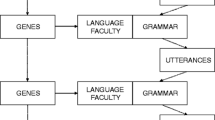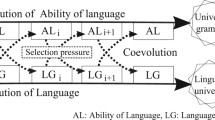Abstract
From the perspective of artificial life, language can be viewed as a complex adaptive system emerging from linguistic interactions between individuals. Language and the human brain have evolved in parallel and by interacting with each other. In this study, we propose a model of language evolution based on biological evolution and learning. In our model, the linguistic space is expressed in the polar coordinate system in which each possible language is expressed as a point. We conduct evolutionary experiments based on this model, and visualize the results in linguistic space. The distribution trajectory of innate linguistic abilities shows the diversification and complexity of language growth. In the extended experiment, in which the angular coordinates represent the additional effect of the cost of plasticity, we observe a general tendency that the cost of plasticity evolves to become smaller. However, it never evolves to be zero, which might suggest that some cost of plasticity producing the Baldwin effect is adaptive in language evolution.
Similar content being viewed by others
Explore related subjects
Discover the latest articles, news and stories from top researchers in related subjects.References
Steels L (1997) The synthetic modeling of language origins. Evolut Commun 1(1):1–34
Watanabe Y, Suzuki R, Arita T (2008) Language evolution and the Baldwin effect. Artif Life Robotics 12:65–69
Suzuki R, Arita T (2008) How learning can guide evolution of communication. Proceedings of Artificial Life XI, pp 608–615
Turney P, Whitley D, Anderson R (1996) Evolution, learning, and instinct: 100 years of the Baldwin effect. Evolut Comput 4(3):4–8
Author information
Authors and Affiliations
Corresponding author
Additional information
This work was presented in part and awarded Young Author Award at the 16th International Symposium on Artificial Life and Robotics, Oita, Japan, January 27–29, 2011
About this article
Cite this article
Azumagakito, T., Suzuki, R. & Arita, T. Visualizing language evolution as an emergent phenomenon based on biological evolution and learning. Artif Life Robotics 16, 366–372 (2011). https://doi.org/10.1007/s10015-011-0953-5
Received:
Accepted:
Published:
Issue Date:
DOI: https://doi.org/10.1007/s10015-011-0953-5




